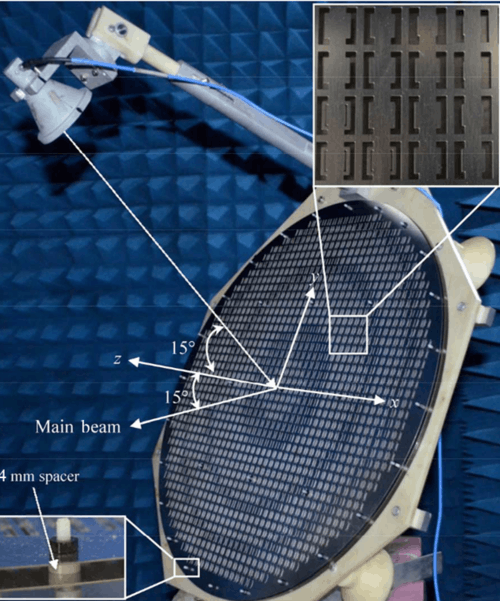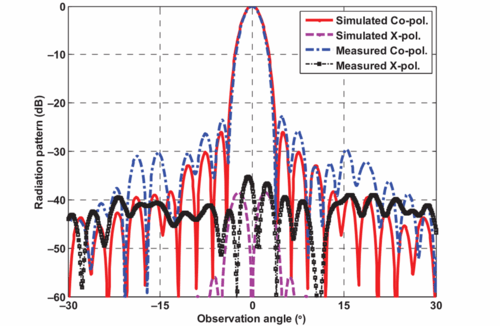Reflectarray antenna
A reflectarray antenna (or just reflectarray) consists of an array of unit cells, illuminated by a feeding antenna (source of electromagnetic waves).[1] [2] The feeding antenna is usually a horn. The unit cells are usually backed by a ground plane, and the incident wave reflects off them towards the direction of the beam. A phase distribution of concentric rings is applied to focus the wavefronts from the feeding antenna into a plane wave (to account for the varying path lengths from the feeding antenna to each unit cell). A progressive phase shift can be applied to the unit cells to steer the beam direction.[3] It is common to offset the feeding antenna to prevent blockage of the beam.[4] In this case, the phase distribution on the reflectarray surface needs to be altered. A reflectarray focuses a beam in a similar way to a parabolic reflector (dish), but with a much thinner form factor.

Phase Distribution
According to[5], in a reflectarray a constant phase of the entire reflected field is achieved in a plane normal to the direction of the desired pencil beam as expressed by:
where is free space wavelength,
is the position vector of the th element/unit cell relative to ,
is the focal length,
is the position vector of th element relative to the origin i.e. centre of the reflectarray,
is the direction vector of the desired pencil beam,
,
and is the phase shift introduced by th unit cell of reflect array to its reflected field relative to the incident field.
For a feed horn located at , the formula for the optimal phase distribution on a conventional reflectarray for a beam in the boresight direction is given by:
where is the phase shift for a unit cell located at coordinates .

Unit Cell Considerations
It is important to analyse the reflection magnitude and the reflection phase across the frequency bandwidth of operation. When designing a reflectarray, we aim to maximise the reflection magnitude to be close to 1 (0 dB) [6]. The reflection phase at each unit cell determines the overall beam shape and direction. Ideally, the total phase shift range would be 360°.[1] The aperture efficiency, and hence gain, of the reflectarray will be reduced if the angle of incidence to the unit cells is not considered, or if spillover occurs or illumination of the reflectarray is not optimal (see also transmitarrays).[2] Similarly, phase errors due to quantisation into a discrete number of phase states for digital control can also reduce the gain.[7]
A fixed reflectarray has a single beam direction per feed. Changing the shape of the unit cells alters their reflection phase. The unit cells cannot be reconfigured. This has applications in point-to-point communications, or for a satellite covering a specific geographic region (with a fixed beam contour).[8] A reconfigurable reflectarray has unit cells whose phase can be electronically controlled in real-time to steer the beam or change its shape. Several methods have been used to implement reconfigurable reflectarray unit cells, including PIN diodes[9] [10], liquid crystal[11] [12] [13] [14], and novel materials. Each of these methods introduces loss which reduces the efficiency of the unit cells. Linearity (such as distortion due to the diodes) also needs to be considered to minimise out-of-band radiation which could interfere with users on adjacent frequencies.[15]
Other Types of Reflectarrays
In satellite communications, is it necessary to produce multiple beams per feed, sometimes operating at different frequencies and polarisations [16]. An example of this is the four-colour frequency reuse scheme.[16] Circular polarisation is commonly used to reduce the effect of atmospheric depolarisation on the communication system performance.[17] A dual-band reflectarray has two different passband frequencies, for example for uplink and downlink.[18] A bifocal reflectarray has two principle foci, so can focus wavefronts to or from two feeding antennas simultaneously.[19] A dual reflectarray consists of two stages of reflection, in which the beam is first focused by one reflectarray, then by another. The phase distribution on each reflectarray must be carefully calculated to ensure that the phase derivatives are consistent with the angle of incidence of the rays [19] The ratio of the sizes and positions of these reflectarrays can be used to achieve quasi-optical magnification (narrowing of the beam).[20]
See also
- Phased array
- Metamaterial
- Transmitarray Antenna
- Millimeter Wave
- Beamforming
References
- R. Deng, F. Yang et al., "A Low-Cost Metal-Only Reflectarray Using Modified Slot-Type Phoenix Element with 360° Phase Coverage," IEEE Transactions on Antennas and Propagation, vol. 64, no. 4, pp. 1556–1560, 2016.
- D. M. Pozar, S. D. Targonski, and H. D. Syrigos, "Design of millimeter wave microstrip reflectarrays," IEEE Transactions on Antennas and Propagation, vol. 45, no. 2, pp. 287–296, 1997.
- P. Nayeri, F. Yang, and A. Z. Elsherbeni, "Beam-scanning reflectarray antennas: A technical overview and state of the art," IEEE Antennas and Propagation Magazine, Aug. 2015, pp. 32-47.
- Y. Huang and K. Boyle, "Antennas: From Theory to Practice", 1st ed. Chichester, UK: John Wiley & Sons Ltd, 2008.
- S. V. Hum and J. Perruisseau-Carrier, "Reconfigurable reflectarrays and array lenses for dynamic antenna beam control: A review," IEEE Transactions on Antennas and Propagation, vol. 62, no. 1, pp. 183–198, 2014.
- G. Ahmad, T. W. C. Brown, C. I. Underwood, and T. H. Loh, “An investigation of millimeter wave reflectarrays for small satellite platforms," Acta Astronautica, vol. 151, June 2018, pp. 475–486.
- G. Ahmad, T. W. C. Brown, C. I. Underwood, and T. H. Loh, “How coarse is too coarse in electrically large reflectarray smart antennas? A phase quantization case study at millimeter wave bands,” in 2017 International Workshop on Electromagnetics: Applications and Student Innovation Competition, May 2017, pp. 135–137.
- H. Legay et al., "A 1.3 m facetted reflectarray in Ku band," in Proc. 2012 15th International Symposium on Antenna Technology and Applied Electromagnetics (ANTEM), 2012.
- H. Yang, F. Yang, et al, "A 1600-element dual-frequency electronically reconfigurable reflectarray at X/Ku-band," IEEE Transactions on Antennas and Propagation, vol. 65, no. 6, pp. 3024–3032, 2017.
- M. N. Bin Zawawi, “New Antenna for Millimetre Wave Radar,” Ph.D. dissertation, Université Nice Sophia Antipolis, France, 2015.
- S. Bildik, S. Dieter, C. Fritzsch, W. Menzel, and R. Jakoby, "Reconfigurable folded reflectarray antenna based upon liquid crystal technology," IEEE Transactions on Antennas and Propagation, vol. 63, no. 1, pp. 122–132, 2015.
- G. Perez-Palomino, "Contribution to the Analysis and Design of Reflectarray Antennas for Reconfigurable Beam Applications above 100 GHz using Liquid Crystal Technology," Ph.D. dissertation, Universidad Politécnica de Madrid, Spain, 2015.
- G. Perez-Palomino, J. Encinar, M. Barba, and E. Carrasco, "Design and evaluation of multi-resonant unit cells based on liquid crystals for reconfigurable reflectarrays," IET Microwaves, Antennas & Propagation, vol. 6, no. 3, pp. 348–354, 2012.
- G. Perez-Palomino, M. Barba, J. A. Encinar, R. Cahill, R. Dickie, P. Baine, and M. Bain, "Design and Demonstration of an Electronically Scanned Reflectarray Antenna at 100 GHz Using Multiresonant Cells Based on Liquid Crystals," IEEE Transactions on Antennas and Propagation, vol. 63, no. 8, pp. 3722–3727, 2015.
- M. S. Shaharil, “Nonlinear characterisation of reconfigurable antennas,” Ph.D. dissertation, University of Birmingham, UK, 2016.
- D. Martínez-de-Rioja, E. M. Martinez-de-Rioja, and J. A. Encinar, "Preliminary Simulations of a 1.8-m Reflectarray Antenna in a Geostationary Satellite to Generate Multi-Spot Coverage," in Proc. 13th European Conference on Antennas and Propagation (EuCAP 2019), Krakow, Poland, 2019.
- D. F. DiFonzo, "The Electrical Engineering Handbook", 2nd ed. Boca Raton, FL, USA: CRC Press LLC, 2000, vol. 74, ch. Satellite and Aerospace.
- P. Naseri and S. V. Hum, "A Dual-Band Dual-Circularly Polarized Reflectarray for K/Ka-Band Space Applications," IEEE Transactions on Antennas and Propagation, 2020 (early access).
- E. M. Martínez de Rioja del Nido, “New Advances on Multi-Frequency and Multi-Beam Reflectarrays within Application to Satellite Antennas in Ka-Band,” Ph.D. dissertation, Universidad Politécnica de Madrid, Spain, 2018.
- C. Sciannella, G. Toso, "An Imaging Reflector System with Reduced Scanning Aberrations," IEEE Transactions on Antennas and Propagation, vol. 63, no. 1, pp. 1342–1350, 2015.